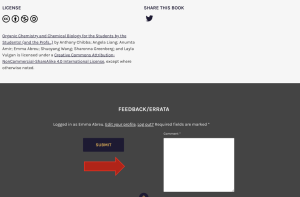Introduction
Textbook Introduction
This textbook aims to provide students with an extra resource to supplement their learning by including different examples, practice problems and explanations than what was shown in lecture. This chapter serves as an introduction to help you navigate the textbook and explain the purpose of the various coloured boxes.
Note that throughout the textbook, you will see the words “substrate”, “reagent” and “reactant” being used interchangeably. A substrate is a molecule that is targeted by an enzyme. A reagent is a molecule added to a substance or mixture to initiate/cause a chemical reaction. A reactant is a substance that undergoes a change during a chemical reaction and is typically referred to as the starting material. In the literature, you will see a combination of these terms being used, so using these words interchangeably is acceptable.
Learning Objectives
The “Learning Objectives” green boxes list the main ideas and concepts that will be spoken about in the chapter. They also serve as a guide to help you identify the key concepts you should be taking away from the chapter. A picture of the “Learning Objectives” box is included below.
Learning Objectives
Learning objectives will be found in these boxes.
Are You Wondering Boxes
The “Are You Wondering?” purple boxes explain concepts in greater detail, and the information in them will not be tested. Examples of information you may find in these boxes include why certain reagents are used, or the importance of reagent conditions. A picture of the “Are you Wondering?” box is included below.
Are You Wondering?
Are You Wondering information will be found in these boxes.
Shaded Box
The light blue shaded box includes mandatory information that students should know. These boxes provide notes, tips or relevant information to help explain concepts. The information in these boxes is testable. A picture of the shaded box is included below.
Shaded Boxes
Key Takeaways
The “Key Takeaways” orange boxes provide a summary of the concepts discussed in that chapter. These boxes are similar to the “Key Concepts” slide at the end of your CHEM 1AA3 lecture slides. Content in these boxes is testable. A picture of the “Key Takeaways” box is included below.
Key Takeaways
Key takeaways will be found in these boxes.
Diversity in Chemistry
The “Diversity in Chemistry” blue boxes highlight talented scientists from diverse backgrounds and the information in them will not be tested. Let us know if there are any other scientists you would like to see included!
Diversity in Chemistry
Diversity in Chemistry will be found in these boxes.
In-Text Questions
The in-text practice questions are found in various formats, such as multiple choice. These questions are meant to test your knowledge on the concepts explained in the chapter. The questions are not designed to be difficult and should instead be used as a guide for you to assess areas you feel comfortable with or areas you might need to work on. Once you click on an option, you will get instant feedback detailing why the answer is correct or incorrect. It is suggested that you use these questions to prepare for your future midterms and exams, as some of these questions were past CHEM 1AA3 midterm and exam questions. A picture of a multiple-choice question is included below. Note that underneath every question is a “Click here for full solutions” link that will take you directly to the question and answer in the Solutions chapter (Chapter 5).
Questions and Comments Feature
If you have questions about any of the content in the textbook (the material, the questions, the solutions, etc.,) or suggestions that we can implement for future students, we would like to know! There are 2 ways you can give us feedback: Microsoft Forms or the Pressbooks comment section. There is a link to the Microsoft Form at the end of each chapter (below the orange “Key Takeaways” box) as pictured below. Note that you must use a McMaster account to access/submit this form.

The Pressbooks comment section can be found at the end of the chapter, after the licensing information as pictured below.


